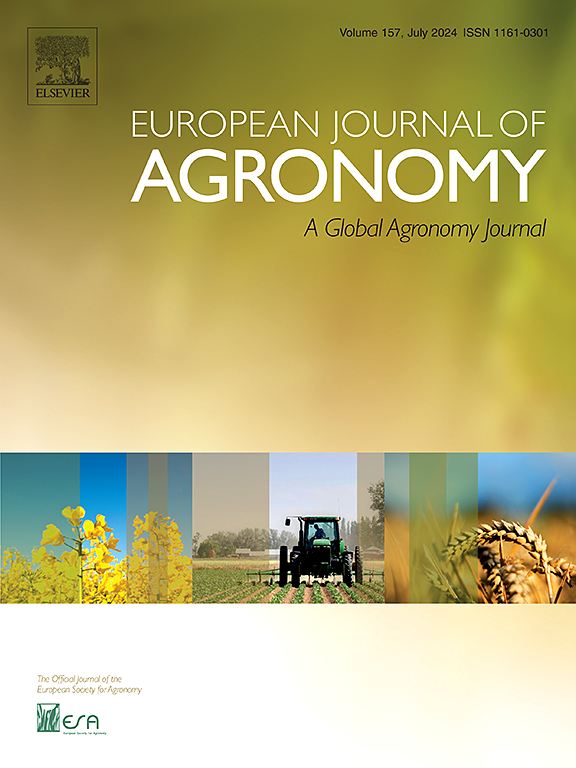Artificial intelligence for early detection and management of Tuta absoluta-induced tomato leaf diseases: A systematic review
IF 4.5
1区 农林科学
Q1 AGRONOMY
引用次数: 0
Abstract
Food security is a critical challenge of the 21st century, increasingly exacerbated by climate change, which facilitates the spread of pests on farms. The South American tomato pinworm, Tuta absoluta (Meyrick), represents a significant global threat to tomato crops. Rising infestations have led to the extensive use of insecticides, raising concerns about pesticide resistance, human health risks, and environmental contamination. Meanwhile, artificial intelligence (AI) provides real-time, scalable, and cost-effective alternatives to traditional pest detection methods, which are labour-intensive and prone to human error. As a result, this study comprehensively assesses the potential of AI in the early detection and mitigation of Tuta absoluta-induced tomato leaf diseases. A systematic literature review was conducted across four major academic databases: ScienceDirect, Scopus, ACM, and IEEE. After a rigorous screening process, 115 studies were selected from an initial pool of 178 papers based on the relevance of their methodologies. This paper synthesises current research on AI methodologies, pest detection technologies, and their agricultural applications for the early detection, identification, and management of Tuta absoluta-induced tomato leaf diseases. Beyond tomato crops, the findings offer broader implications for managing similar pests affecting other economically significant crops. The study concludes with actionable recommendations for integrating AI-driven pest detection into precision agriculture, with the goal of enhancing food security and promoting sustainable farming practices worldwide.
人工智能在番茄叶片病害早期检测与管理中的应用综述
粮食安全是21世纪的一项重大挑战,气候变化加剧了这一挑战,气候变化促进了害虫在农场的传播。南美番茄蛲虫(Tuta absoluta (Meyrick))对番茄作物构成了重大的全球威胁。日益严重的虫害导致了杀虫剂的广泛使用,引发了人们对杀虫剂耐药性、人类健康风险和环境污染的担忧。与此同时,人工智能(AI)为传统的害虫检测方法提供了实时、可扩展和经济高效的替代方案,传统的害虫检测方法是劳动密集型的,容易出现人为错误。因此,本研究全面评估了人工智能在早期发现和缓解马铃薯诱导的番茄叶片疾病方面的潜力。我们对四个主要的学术数据库进行了系统的文献综述:ScienceDirect、Scopus、ACM和IEEE。经过严格的筛选过程,根据研究方法的相关性,从最初的178篇论文中选出了115篇研究。本文综述了人工智能方法、害虫检测技术及其在番茄叶片病害早期检测、识别和管理中的应用研究现状。除了番茄作物,研究结果还为管理影响其他重要经济作物的类似害虫提供了更广泛的启示。该研究最后提出了将人工智能驱动的有害生物检测纳入精准农业的可行建议,目标是在全球范围内加强粮食安全和促进可持续农业做法。
本文章由计算机程序翻译,如有差异,请以英文原文为准。
求助全文
约1分钟内获得全文
求助全文
来源期刊

European Journal of Agronomy
农林科学-农艺学
CiteScore
8.30
自引率
7.70%
发文量
187
审稿时长
4.5 months
期刊介绍:
The European Journal of Agronomy, the official journal of the European Society for Agronomy, publishes original research papers reporting experimental and theoretical contributions to field-based agronomy and crop science. The journal will consider research at the field level for agricultural, horticultural and tree crops, that uses comprehensive and explanatory approaches. The EJA covers the following topics:
crop physiology
crop production and management including irrigation, fertilization and soil management
agroclimatology and modelling
plant-soil relationships
crop quality and post-harvest physiology
farming and cropping systems
agroecosystems and the environment
crop-weed interactions and management
organic farming
horticultural crops
papers from the European Society for Agronomy bi-annual meetings
In determining the suitability of submitted articles for publication, particular scrutiny is placed on the degree of novelty and significance of the research and the extent to which it adds to existing knowledge in agronomy.
 求助内容:
求助内容: 应助结果提醒方式:
应助结果提醒方式:


